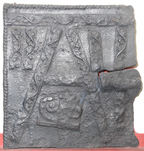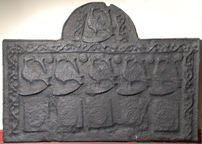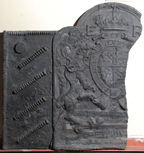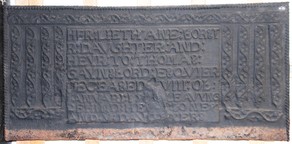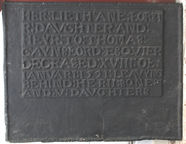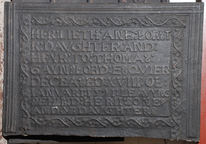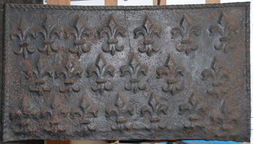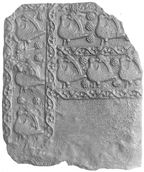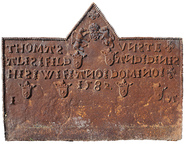-
381
Description: Fragment; left part of rectangle; twisted rope border (top and sides); long, narrow stamp with undulating vine motif, repeated three times in 'A' shape with top bar; short length of same strip repeated six times, one across middle of 'A', two each side of 'A' at top, one lower right; indistinct stamp with swirled floral design between lower legs of 'A'.
Notes: The same vine strip stamp is seen, in both long and short lengths, on many firebacks, indicating a common source. All the stamps were probably derived from redundant furniture.
- Decoration tags:
- rectangular (shape)
- rope (edging)
- simple stamps
- objects
Manufactured: in the mid- to late-16th century possibly at Pounsley Furnace, Framfield in the Weald area of England.
Current location: Anne of Cleves House, Southover High Street, Lewes, East Sussex, England.
Museum number: LH000.913 (part of the Sussex Archaeological Society museum group)
- Attached to series:
- Pounsley series
- Vine strip series
- Furniture stamp firebacks
-
383
Description: Arched rectangular shape; thin twisted rope edging on top and sides; trailing vine strips frame a row of repeated bird (probably swan) stamps (5) above repeated rose en soleil stamps (5); single bird stamp with two short, slanting vine strips in top arch.
Notes: The rose-en-soleil was the badge of King Edward IV and, thus, a Yorkist symbol, while the swan had been adopted by Henry IV and was, therefore, a Lancastrian symbol.
- Decoration tags:
- rectangular with round arch (shape)
- rope (edging)
- simple stamps
- carved stamps
- heraldic
- objects
Manufactured: in the mid- to late-16th century possibly at Pounsley Furnace, Framfield in the Weald area of England.
Current location: Anne of Cleves House, Southover High Street, Lewes, East Sussex, England.
Museum number: LH000.941 (part of the Sussex Archaeological Society museum group)
Citation: Butterfield, W. R., 1916, 'Old Wealden Firebacks', The Connoisseur, 46, pp. 197-209.
-
403
Description: Fragment; arched rectangular shape with rounded corners; ovolo within fillet moulding all round; oval Tudor royal shield with garter surrounding, topped with a royal crown; dragon and (missing)greyhound supporters; initials split by crown; inscription on a fillet between legs of supporters, behind garter finial; motto on an Ionic plinth at bottom; rectangular side panels with twisted rope edging top and side; a short length of turned dowel stamped four times, diagonally, on each panel; a circular disc with concentric grooves in top left corner.
Notes: Similar to a fireback in the Victoria & Albert Museum, but differentiated by the twisted rope edging of the side panel and the addition of the grooved disc. The disparity between the worn surface of the armorial panel and the greater clarity of the extensions indicates that the extended casting was made using an already well-used armorial fireback and therefore at a substantially later date.
Inscription: E R / HONY SOIT QUE ... / Made in Sussex by J... / DV ET MOV...
Arms: Tudor royal - Edward VI
- Decoration tags:
- rectangular with round arch (shape)
- rope (edging)
- simple stamps
- carved stamps
- whole carved pattern
- extension panels
- armorial
- royal
- text
- objects
Manufactured: in the late-16th century in the Weald area of England.
Current location: Anne of Cleves House, Southover High Street, Lewes, East Sussex, England.
Museum number: LH000.916 (part of the Sussex Archaeological Society museum group)
- Attached to series:
- Pounsley series
- John Harvo series
- Tudor royal armorial firebacks
-
431
Description: Rectangular; twisted rope edging (top and sides); undulating vine strip repeated in a line four times along the top, and four times vertically on each side of central inscription panel, with shorter vine strip repeated below vertical strips on each side.
Notes: One of several firebacks that re-use the memorial inscription to 'Ane Forster' (Anne Foster) of Crowhurst, Surrey. The vine strip stamp is seen on other firebacks. The excrescence obscuring part of the text was probably the result of clumsy pouring of the iron during casting which displaced some of the sand mould.
Inscription: HER:LIETH:ANE:FORST / R:DAVGHTER:AND: / HEYR:TO:THOMAS: / GAYNSFORD:ESQVIER / DECEASED:XVIII:OF: / IANVARI:1591:LEAVYNG / BEHIND:HER:II:SONES: / AND:V:DAVGHTERS
- Decoration tags:
- rectangular (shape)
- rope (edging)
- simple stamps
- carved stamps
- carved pattern panels
- planklines
- text
Manufactured: in the late-16th century possibly at Pounsley Furnace, Framfield in the Weald area of England.
Current location: Hall Place, Bexley, Kent, England.
Museum number: LH000.904 (part of the Sussex Archaeological Society museum group)
-
432
Description: Rectangular; twisted rope edging; top centre, inscription panel.
Notes: One of several firebacks that re-use the memorial inscription to 'Ane Forster' (Anne Foster) of Crowhurst, Surrey. Formerly in the John H. Every collection, for which it was purchased in 1921 in Broadway, Worcs., having allegedly come from Billingshurst, Sussex.
Inscription: HER:LIETH:ANE:FORST / R:DAVGHTER:AND: / HEYR:TO:THOMAS: / GAYNSFORD:ESQVIER / DECEASED:XVIII:OF: / IANVARI:1591:LEAVYNG / BEHIND:HER:II:SONES: / AND:V:DAVGHTERS
- Decoration tags:
- rectangular (shape)
- rope (edging)
- carved pattern panels
- planklines
- text
Manufactured: in the late-16th century possibly at Pounsley Furnace, Framfield in the Weald area of England.
Current location: Anne of Cleves House, Southover High Street, Lewes, East Sussex, England.
Museum number: Shoreham 92/1900 (part of the Sussex Archaeological Society museum group)
- Attached to series:
- Pounsley series
- Anne Forster series
- Epitaph firebacks
-
436
Description: Rectangular; carved moulding edging; centre, inscription panel; undulating vine strip stamp repeated thirteen times to form an inner border along each side of the inscription panel.
Notes: The only fireback of the Anne Forster series to have edging formed from wooden moulding probably from dismantled furniture or panelling. Given to the Sussex Archaeological Society in 1850 by Sir Henry Shiffner Bt., of Coombe Place, Hamsey, Sussex. A former occupant of his burnt-out estate cottage, where it had been found, was said to have been a Miss Forster.
Inscription: HER:LIETH:ANE:FORST / R:DAVGHTER:AND: / HEYR:TO:THOMAS: / GAYNSFORD:ESQVIER / DECEASED:XVIII:OF: / IANVARI:1591:LEAVYNG / BEHIND:HER:II:SONES: / AND:V:DAVGHTERS
- Decoration tags:
- rectangular (shape)
- complex individual (edging)
- simple stamps
- carved pattern panels
- planklines
- text
Manufactured: in the late-16th century possibly at Pounsley Furnace, Framfield in the Weald area of England.
Current location: Anne of Cleves House, Southover High Street, Lewes, East Sussex, England.
(part of the Sussex Archaeological Society museum group)
Citation: Dawson, C., 1903, 'Sussex Iron Work and Pottery', Sussex Archaeological Collections, 46, pp. 1-54.
-
443
Description: Canted rectangle; plain plate with two rows of fleurs de lys, eight in the top row, three off set above the other five, and five in a single row along the bottom.
Notes: The fleurs-de-lys are the same as are seen on firebacks thought to have been cast at Pounsley.
- Decoration tags:
- rectangular with canted top corners (shape)
- none (edging)
- carved stamps
- heraldic
Manufactured: in the mid- to late-16th century possibly at Pounsley Furnace, Framfield in the Weald area of England.
Current location: Anne of Cleves House, Southover High Street, Lewes, East Sussex, England.
(part of the Sussex Archaeological Society museum group)
Citation: Butterfield, W. R., 1916, 'Old Wealden Firebacks', The Connoisseur, 46, pp. 197-209.
- Attached to series:
- Pounsley series
-
448
Description: Rectangular; twisted rope edging (top and sides); fleur de lys arranged in a pattern of 20, in three rows: 7-6-7.
Notes: A type of fleur-de-lys used on firebacks possibly cast at Pounsley Furnace.
- Decoration tags:
- rectangular (shape)
- rope (edging)
- carved stamps
- heraldic
Manufactured: in the mid- to late-16th century possibly at Pounsley Furnace, Framfield in the Weald area of England.
Current location: Hall Place, Bexley, Kent, England.
Museum number: 1944.24.039 (part of the Sussex Archaeological Society museum group)
- Attached to series:
- Pounsley series
-
854
Description: Sub-rectangular fragment; undulating vine tendril strip repeated twice vertically from left edge with a bird stamp (probably a swan, a Lancastrian badge) repeated three times between, interspersed with a grape cluster stamp repeated seven times; vine tendril stamp repeated twice horizontally at right angles to rightmost vertical strip, three bird stamps between strips and two above, interspersed with seven grape cluster stamps.
Notes: This fragment incorporates common elements from a large series of firebacks.
- Decoration tags:
- rectangular (shape)
- trailing vine (edging)
- carved stamps
- animals
- plants
Manufactured: in the mid- to late-16th century possibly at Pounsley Furnace, Framfield in the Weald area of England.
Current location: Anne of Cleves House, Southover High Street, Lewes, East Sussex, England.
Museum number: LH000.924 (part of the Sussex Archaeological Society museum group)
- Attached to series:
- Pounsley series
- Vine strip series
- Swan series
- Furniture stamp firebacks
-
472
Description: Rectangular with central triangular arch; twisted rope edging (top and sides); in arch, on top, a small cross formed of fleurs-de-lys above a rose and crown with dragon and lion supporters above two crowned shields each bearing a small fleur-de-lys; text across top half, a small cross formed of fleurs-de-lys ending the first and third lines, the top two lines split by the crowned shields, each word separated by two opposed fleurs; below the text, four crowned shields each with a fleur-de-lys, the date between the middle two; lower left, 'I'; lower right, 'A'.
Notes: The inscription can be interpreted as Thomas Anstie alias Field and Denise his wife (etc.), the surname Anstie alias Field being known in the 16th century in central Sussex. A Thomas Anstye married Denys Joyner at Wivelsfield, Sussex on 5th June 1564; illustrated in Lower, 1849 p. 189 with some errors in transcription of the inscription; formerly at 'Misfield' (Miswell), Worth, Sussex. One of a small series of distinctive firebacks cast in 1582, most with inscriptions dedicated to pairs of individuals; the initials IA are likely to be of the founder as they appear in the same arrangement on the other firebacks; the rose and crown and supporters stamp can also be seen on a large fireback, dated 1593, formerly at Baynard's Park, Surrey (no. 200).
Inscription: THOMAS VNSTE / ALIS : FILD AND DINIS / HIS : WIF: ANO : DOMINO: / 1582 / I A
- Decoration tags:
- rectangular with triangular arch (shape)
- rope (edging)
- carved stamps
- individual letters
- individual numbers
- heraldic
- text
Manufactured: in 1582 possibly at Pounsley Furnace, Framfield in the Weald area of England.
Current location: Gwesty Seren Hotel (formerly Bryn Llewellyn), Allt Goch, Llan Ffestiniog, Gwynedd, Wales.
- Attached to series:
- Pounsley series
- 1582 IA series
